Tuesday, October 31, 2006:
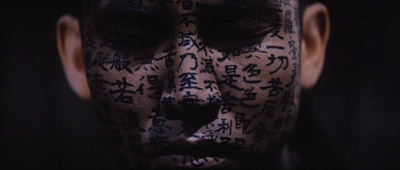
The Orb -- Ghostdancing
Neko Case -- Ghost Wiring
Kwaidan is a quartet of ghost stories directed by Masaki Kobayashi based on Lafcadio Hearn's adaptations of Japanese legends. Often classed a horror film, it's not especially horrifying: the stories are simple, the pacing deliberate, and for a gaijin audience the resolutions are predictable (whereas for a Japanese audience, there's less need for prediction: people in the audience unfamiliar with the legends would still know that the film's title means "ghost story").
In the first segment, "The Black Hair," a samurai leaves his devoted wife to marry a woman from a prestigious family, then realises both her selfishness and his own and returns to his first wife. In the second, "The Woman of the Snow," a woodcutter sees his companion killed by Yuki-onna, the spirit of winter; she spares him on the condition that he never tell anyone what he's seen. In the third, "Hoichi the Earless," a blind biwa player is approached by samurai ghosts and ordered to play for a long-dead audience. In the fourth and final segment, "In a Cup of Tea," a samurai finds that whenever he pours himself a bowl of water, it always reflects a man who isn't there.
Though the film fails to terrify, its pleasures lie elsewhere: Kobayashi gifts the stories with a painstaking visual sense, favoring bold composition:
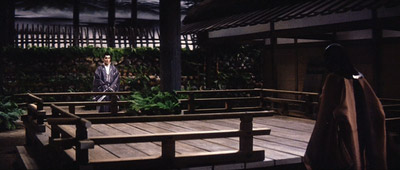
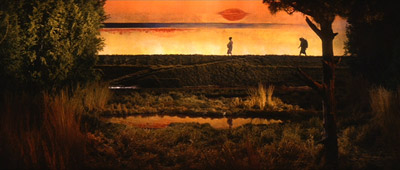
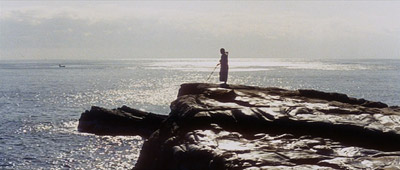
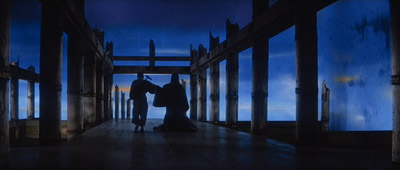
He films in the studio and uses blatant backdrops in outdoor scenes:
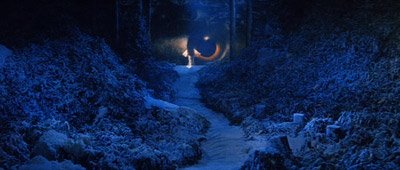
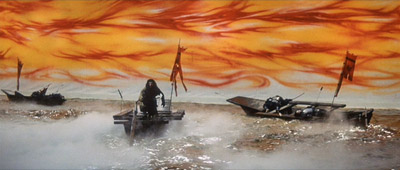
He makes use of theatrical lighting:
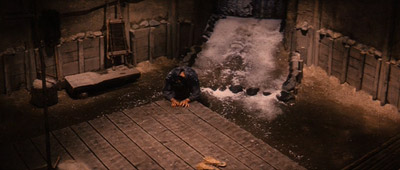

Colors are carefully controlled, often dominated by neutrals, and with only a few accents outside the dominant color scheme:
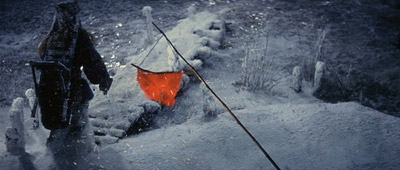
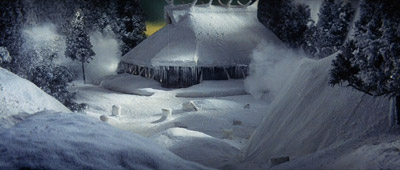
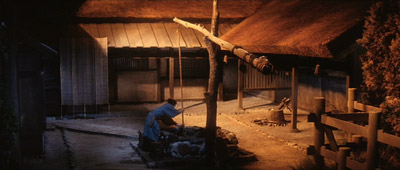
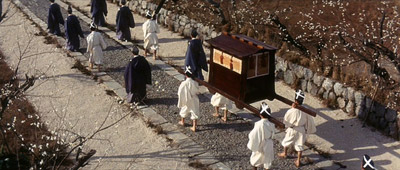
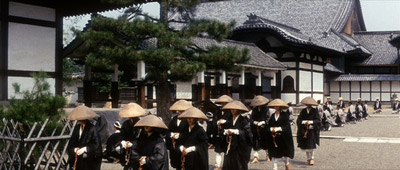
The Criterion Collection's essay on Kwaidan
[The Orb -- Cydonia]
[Neko Case -- Blacklisted]
The Orb, Neko again, Kwaidan

The Orb -- Ghostdancing
Neko Case -- Ghost Wiring
Kwaidan is a quartet of ghost stories directed by Masaki Kobayashi based on Lafcadio Hearn's adaptations of Japanese legends. Often classed a horror film, it's not especially horrifying: the stories are simple, the pacing deliberate, and for a gaijin audience the resolutions are predictable (whereas for a Japanese audience, there's less need for prediction: people in the audience unfamiliar with the legends would still know that the film's title means "ghost story").
In the first segment, "The Black Hair," a samurai leaves his devoted wife to marry a woman from a prestigious family, then realises both her selfishness and his own and returns to his first wife. In the second, "The Woman of the Snow," a woodcutter sees his companion killed by Yuki-onna, the spirit of winter; she spares him on the condition that he never tell anyone what he's seen. In the third, "Hoichi the Earless," a blind biwa player is approached by samurai ghosts and ordered to play for a long-dead audience. In the fourth and final segment, "In a Cup of Tea," a samurai finds that whenever he pours himself a bowl of water, it always reflects a man who isn't there.
Though the film fails to terrify, its pleasures lie elsewhere: Kobayashi gifts the stories with a painstaking visual sense, favoring bold composition:




He films in the studio and uses blatant backdrops in outdoor scenes:


He makes use of theatrical lighting:


Colors are carefully controlled, often dominated by neutrals, and with only a few accents outside the dominant color scheme:





The Criterion Collection's essay on Kwaidan
[The Orb -- Cydonia]
[Neko Case -- Blacklisted]
Labels: alt country, electronica, horror, movies
Comments:
<< Home
Wow, what eye-popping compositions, Tuwa!
I've always meant to see KWAIDAN, and shall head over to Netflix now...
I've always meant to see KWAIDAN, and shall head over to Netflix now...
Girish, this film and Days of Heaven might be the two films with the most beautiful cinematography I've ever seen. Kobayashi's background at a painter really shows here; I'm quite eager to see more of his work.
Mm. It's all unashamedly artificial, and constantly calling attention to its own artificiality: the sets always look like sets; the backdrops always look like paintings; the lighting never looks "natural." It's very theatrical, or maybe ritualistic.
That extends to the sound as well, and that's the problem for me. There's no location sound at all—it's all looped in the studio. That's not the problem—it fits in with the film's overall aesthetic of giving Kobayishi absolute control of every aspect; the problem is that the sound was mixed way too hot, and there's all kinds of nasty clipping and distortion. It's a beautiful film to watch, but really unpleasant to listen to.
Knowing the attention that Criterion gives to their reissues, I can only assume that this was the best audio track they could find, which leads me to think the problem was in the mastering. Which is a damned shame: such a gorgeous film deserves much better.
That extends to the sound as well, and that's the problem for me. There's no location sound at all—it's all looped in the studio. That's not the problem—it fits in with the film's overall aesthetic of giving Kobayishi absolute control of every aspect; the problem is that the sound was mixed way too hot, and there's all kinds of nasty clipping and distortion. It's a beautiful film to watch, but really unpleasant to listen to.
Knowing the attention that Criterion gives to their reissues, I can only assume that this was the best audio track they could find, which leads me to think the problem was in the mastering. Which is a damned shame: such a gorgeous film deserves much better.
I didn't notice any clipping on my computer's speakers, but I'm sure that's because they're cheap speakers and I've gotten used to hearing DVDs on them. In any case, yes, that's a shame if there's clipping on the track, especially if that means it was mastered wrong (at least until some future millionaire develops a way to unclip audio).
¶ Post a Comment
<< Home
